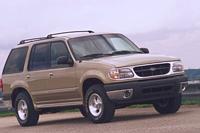Ford Expedition Becomes Only SUV to Earn Top Government Crash
Ratings
DETROIT, Jan. 9 The Ford Expedition has become the only
Sport Utility Vehicle (SUV) to earn a double five-star rating in U.S.
government frontal crash testing.
"All of our SUVs perform well in real world situations and consumer crash
tests," said Gurminder Bedi, Vice President, Truck Product Development.
"However, this accomplishment is special because we had to reach this level of
crash test performance without jeopardizing any of the advancements we've made
in the area of vehicle-to-vehicle compatibility."
Expedition was able to earn the government's top rating for frontal crash
tests because of additional enhancements to the SUV's restraint system. For
2001, the Expedition's safety belt system is equipped with technologies called
pretensioners and energy management retractors.
Pretensioners are special devices located in the retractors of the front-
seat safety belts. They tighten the belts and help prevent belted occupants
from sliding and bouncing around during a crash.
If crash forces rise to severe levels, a metal bar tucked in the center of
the spool of the safety belt retractor -- called an energy management
retractor -- twists like a wrung-out washcloth.
Such action releases small amounts of safety belt webbing in a controlled
manner and helps reduce the risk of force-related injuries, especially to the
occupant's chest.
These technologies build on the Expedition's existing strong structural
performance in crashes. Its safety cage is designed to absorb forces from a
crash, helping to reduce the forces reaching either occupants of the SUV or
another vehicle that may be involved in the crash.
The Expedition continues to be the best-selling full-size SUV in the U.S.
"Expedition provides the capabilities to experience the 'real' outdoors in
surprising comfort and control," said Doug Walczak, Expedition Marketing
Manager. "The vehicle's double five-star crash rating is further evidence
that it provides the confidence and capability for rugged adventure."
The 2001 model year Expedition was crash-tested by the National Highway
Traffic Safety Administration (NHTSA) in December. The test consists of
crashing the Expedition into a fixed concrete barrier at 35 mph, creating
essentially the same conditions as two identical vehicles colliding head-on
while each is traveling at 35 mph. Then, scientists examine impact data
provided by instrumented dummies inside the vehicle during the crash test.
Paying special attention to head and chest injury data, government
researchers from the National Highway Traffic Safety Administration assign a
"star" ranking that corresponds to the level of risk the dummies had in this
test of experiencing a serious head or chest injury.
NHTSA has said that a five-star rating indicates that in its 35 mph
frontal crash test, the belted dummy measurements correlated to a 10 percent
or less chance of any serious head or chest injury.
While Expedition and similarly sized SUVs are not tested for side impacts,
all Ford sport utility vehicles are rated at five or four stars for both
applicable frontal and side impact testing conducted by NHTSA.
The Expedition began production in 1997. It is produced at the Michigan
Truck Plant in Wayne, Michigan.
For the 2000 model year, Ford had 10 vehicles to earn double five-star
ratings, more than any other automaker. While many more will still be tested
by NHTSA, so far for 2001, eight Ford Motor Company vehicles have
earned double five-star frontal crash ratings. Both the Mercury Villager
minivan and Lincoln Town Car have also reached this level for the first time.
Other double five-star Ford Motor Company vehicles are: Ford Focus, Taurus
and Ranger electric pickup truck, Mercury Sable and Volvo S80.



